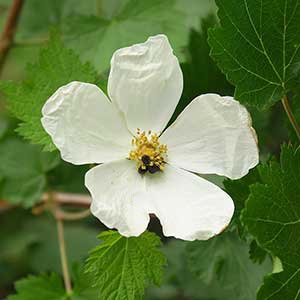Rubus bartonianus
Rubus idaeus
Barton's raspberry, bartonberry
American red raspberry, common red raspberry, framboisier, nagoonberry, North American red raspberry, red raspberry, western red raspberry
erect, sparsely short-hairy, glabrescent, eglandular, not pruinose.
biennial, erect, glabrescent, eglandular or stipitate-glandular, strongly pruinose;
prickles absent or sparse to dense, erect, weak, 1–4 mm, broad-based;
bristles present or absent.
deciduous, simple;
stipules lanceolate, 4–6 mm;
blade cordate to broadly ovate, (2–)2.5–4(–5) × (2.5–)3.5–4.5(–5.5) cm, base deeply cordate, 3–5-lobed, lobe apices acute to obtuse, margins coarsely doubly dentate, abaxial surfaces glabrous or sparsely hairy, eglandular or sparsely stipitate-glandular.
deciduous, pinnately compound;
stipules filiform, 5–10 mm;
petiole unarmed or with prickles, strigose or glabrous, glandular or eglandular;
terminal leaflets petiolulate, lateral sessile or subsessile;
leaflets 3–5(–7), terminal ovate to lanceolate, 7–15 × 4–11 cm, base rounded to cordate, unlobed or 2-lobed, margins serrate to doubly serrate, apex acute to attenuate, abaxial surfaces unarmed or with prickles, strongly white-tomentose, eglandular or glandular.
1-flowered.
terminal and axillary, (1–)3–7(–20)-flowered, racemiform.
moderately hairy, eglandular or sparsely stipitate-glandular.
unarmed or prickles sparse, hooked, glabrous or sparsely pubescent, stipitate-glandular or eglandular.
bisexual;
petals white, obovate, (15–)20–25 mm;
filaments filiform;
ovaries glabrous, styles clavate, villous.
bisexual;
petals white to greenish white, spatulate to obovate, 5–10 mm;
filaments filiform or slightly dilated basally;
ovaries pubescent.
deep red, hemispheric, to 1 cm;
drupelets 10–30, coherent, separating from torus.
usually red to whitish, rarely amber, globose to conic, 0.5–2 cm;
drupelets 10–60, coherent, separating from torus.
Rubus bartonianus
Rubus idaeus
Of conservation concern.
Rubus bartonianus is distinguished from the other flowering raspberries within its geographic range by its erect, unarmed stems, relatively small, simple leaves with acute to obtuse lobes, deeply cordate bases, sparsely hairy or glabrous abaxial surfaces, relatively large flowers with white petals, and densely long-hairy, clavate styles. The leaves superficially resemble those of Acer glabrum or some species of Ribes.
Rubus bartonianus is most similar to R. neomexicanus but especially R. deliciosus. The species is known only from the Snake River Canyon of Idaho and Oregon.
(Discussion copyrighted by Flora of North America; reprinted with permission.)
Subspecies 2 (2 in the flora).
Rubus idaeus is the source of most of the cultivated red and amber raspberries. Plants were used by the Cherokee, Cree, and others as a parturient; an infusion of dried leaves in water was used to prepare the uterus for childbirth and help women recover after childbirth (D. E. Moerman 1998; D. Hoffman 2003).
(Discussion copyrighted by Flora of North America; reprinted with permission.)
1. Stems eglandular 13a | subsp. idaeus |
1. Stems stipitate-glandular. | subsp. strigosus |
- Local floras:
BC,
OR,
WA
- Local Web sites:
CalFlora,
CalPhotos,
Flora NW,
Go Botany,
IL Wildflowers,
MD Biodiversity,
MI Flora,
MN Wildflowers,
MO Plants,
PNW Herbaria,
Turner Photog.
WildflowerSearch
iNaturalist (observations)
USDA Plants Database
- LBJ Wildflower Center
- SEINet
- Plants of the World Online
- Encyclopedia of Life
- Wikipedia
- Google Image Search


